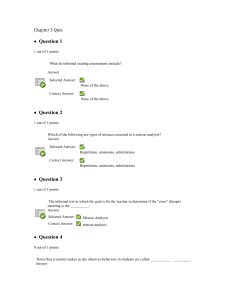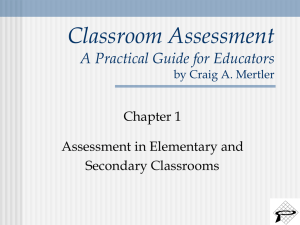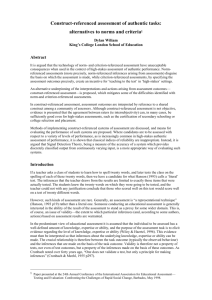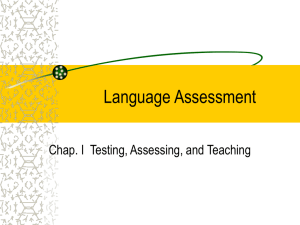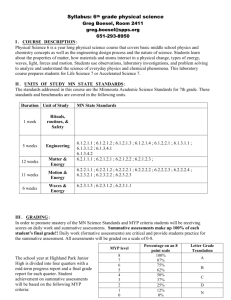Construct-referenced assessment of authentic tasks
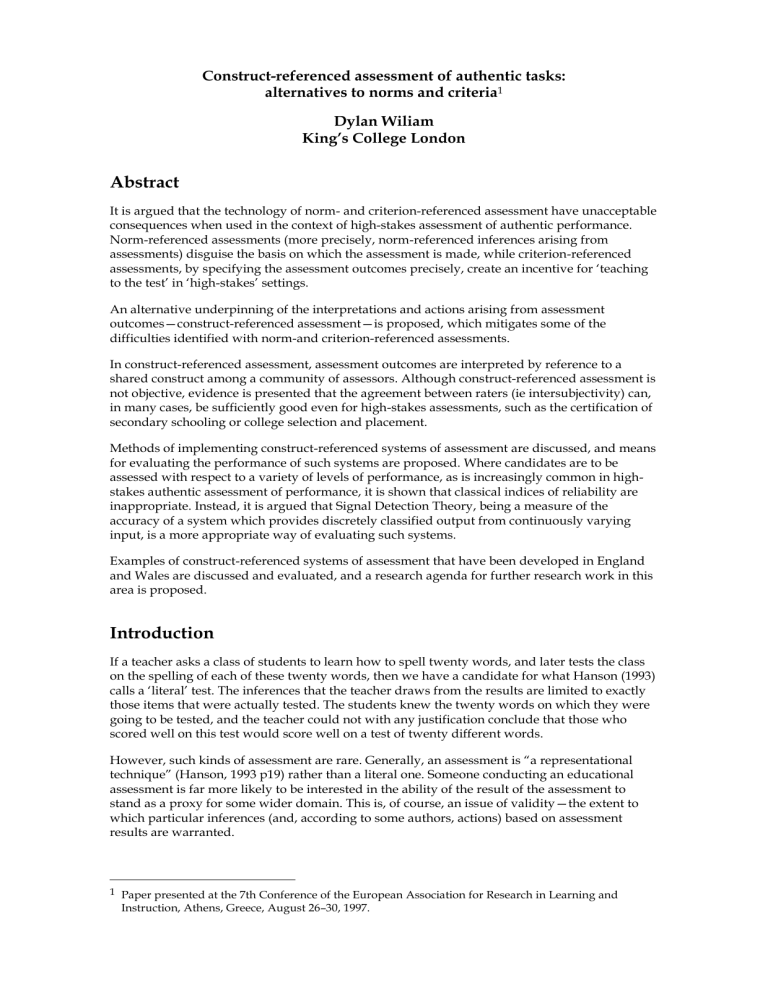
Construct-referenced assessment of authentic tasks: alternatives to norms and criteria
1
Dylan Wiliam
King’s College London
Abstract
It is argued that the technology of norm- and criterion-referenced assessment have unacceptable consequences when used in the context of high-stakes assessment of authentic performance.
Norm-referenced assessments (more precisely, norm-referenced inferences arising from assessments) disguise the basis on which the assessment is made, while criterion-referenced assessments, by specifying the assessment outcomes precisely, create an incentive for ‘teaching to the test’ in ‘high-stakes’ settings.
An alternative underpinning of the interpretations and actions arising from assessment outcomes—construct-referenced assessment—is proposed, which mitigates some of the difficulties identified with norm-and criterion-referenced assessments.
In construct-referenced assessment, assessment outcomes are interpreted by reference to a shared construct among a community of assessors. Although construct-referenced assessment is not objective, evidence is presented that the agreement between raters (ie intersubjectivity) can, in many cases, be sufficiently good even for high-stakes assessments, such as the certification of secondary schooling or college selection and placement.
Methods of implementing construct-referenced systems of assessment are discussed, and means for evaluating the performance of such systems are proposed. Where candidates are to be assessed with respect to a variety of levels of performance, as is increasingly common in highstakes authentic assessment of performance, it is shown that classical indices of reliability are inappropriate. Instead, it is argued that Signal Detection Theory, being a measure of the accuracy of a system which provides discretely classified output from continuously varying input, is a more appropriate way of evaluating such systems.
Examples of construct-referenced systems of assessment that have been developed in England and Wales are discussed and evaluated, and a research agenda for further research work in this area is proposed.
Introduction
If a teacher asks a class of students to learn how to spell twenty words, and later tests the class on the spelling of each of these twenty words, then we have a candidate for what Hanson (1993) calls a ‘literal’ test. The inferences that the teacher draws from the results are limited to exactly those items that were actually tested. The students knew the twenty words on which they were going to be tested, and the teacher could not with any justification conclude that those who scored well on this test would score well on a test of twenty different words.
However, such kinds of assessment are rare. Generally, an assessment is “a representational technique” (Hanson, 1993 p19) rather than a literal one. Someone conducting an educational assessment is far more likely to be interested in the ability of the result of the assessment to stand as a proxy for some wider domain. This is, of course, an issue of validity—the extent to which particular inferences (and, according to some authors, actions) based on assessment results are warranted.
1 Paper presented at the 7th Conference of the European Association for Research in Learning and
Instruction, Athens, Greece, August 26–30, 1997.
Norm-referenced assessments
For most of the history of educational assessment, the primary method of interpreting the results of assessment has been to compare the results of a specific individual with a welldefined group of other individuals (often called the ‘norm’ group). Probably the bestdocumented such group is the group of college bound students (primarily from the northeastern United States) who in 1941 formed the norm group for the Scholastic Aptitude Test.
Norm-referenced assessments have been subjected to a great deal of criticism over the past thirty years, although much of this criticism has generally overstated the amount of normreferencing actually used in standard setting, and has frequently confused norm-referenced assessment with cohort-referenced assessment (Wiliam, 1996). Nevertheless, it is the case that with norm-referenced assessments it is easy to relate an individual’s performance to that of a norm group without knowing what, exactly, the assessment is representing.
Criterion-referenced assessments
This desire for greater clarity about the relationship between the assessment and what it represented led, in the early 1960s, to the development of criterion-referenced assessments. The essence of criterion-referenced assessment is that the domain to which inferences are to be made is specified with great precision (Popham, 1980). In particular, it was hoped that performance domains could be specified so precisely that items for assessing the domain could be generated automatically and uncontroversially (Popham, op cit).
However, as Angoff (1974) has pointed out, any criterion-referenced assessment is underpinned by a set of norm-referenced assumptions, because the assessments areused in social settings. In measurement terms, the criterion ‘can high jump two metres’ is no more interesting than ‘can high jump ten metres’ or ‘can high jump one metre’. It is only by reference to a particular population (in this case human beings), that the first has some interest, while the latter two do not.
The need for interepretation is clearly illustrated in the UK car driving test, which requires, among other things, that the driver “Can cause the car to face in the opposite direction by means of the forward and reverse gears”. This is commonly referred to as the ‘three-point-turn’, but it is also likely that a five point-turn would be acceptable. Even a seven-point turn might well be regarded as acceptable, but only if the road in which the turn was attempted were quite narrow. A forty-three point turn, while clearly satisfying the literal requirements of the criterion, would almost certainly not be regarded as acceptable. The criterion is there to distinguish between acceptable and unacceptable levels of performance, and we therefore have to use norms, howver implicitly, to determine appropriate interpretations.
Another competence required by the driving test is that the candidate can reverse the car around a corner without mounting the curb, nor moving too far into the road, but how far is too far?’ In practice, the criterion is interpreted with respect to the target population; a tolerance of six inches would result in nobody passing the test, and a tolerance of six feet would result in almost everybody succeeding, thus robbing the criterion of its power to discriminate between acceptable and unacceptable levels of performance.
Any criterion has what might be termed ‘plasticity’ 2 ; there are a range of assessment items that, on the face of it, would appear to be assessing the criterion, and yet these items can be very different as far as student are concerned, and need to be chosen carefully to ensure that the criterion is interpreted so as to be useful, rather than resulting in a situation that nobody, or everybody achieves it.
2
The use of this term to describe the extent to which the facility of a criterion could be altered according to the interpretation made was suggested to me by
Jon Ogborn, to whom I am grateful.
At first sight, it might be thought that these difficulties exist only for poorly specified domains, but even in mathematics—generally regarded as one in which performance criteria can be formulated with greatest precision and clarity—it is generally found that criteria are ambiguous. For example, consider an apparently precise criterion such as ‘Can compare two fractions to find the larger’. We might further qualify the criterion by requiring that the fractions are proper and that the numerators and the denominators of the fractions are both less than ten.
This gives us a domain of 351 possible items (ie pairs of fractions), even if we take the almost certainly unjustifiable step of regarding all question contexts as equivalent. As might be expected, the facilities of these items are not all equal. If the two fractions were 5
7
and 3
7
, then about 90% of English 14-year-olds could be expected to get it right while if the pair were 3
4
and
4
5
, then about 75% could be expected to get it right. However, if we choose the pair 5
7
and 5
9 then only around 14% get it right (Hart, 1981). Which kinds of items are actually chosen then becomes an important issue. The typical response to this question has been to assume that tests are made up of items randomly chosen from the whole domain and the whole of classical test theory is based on this assumption. However, as Jane Loevinger pointed out as long ago as
1947, this means that we should also include bad items as well as good items.
As Shlomo Vinner has pointed out, many children compare fractions by a naive ‘the bigger fraction has the smallest denominator’ strategy, so that they would correctly conclude that 2
5 was larger than
7
1 but for the ‘wrong’ reason. Should this
This emphasis on ‘criterion-referenced clarity’ (Popham, 1994a) has, in many countries, resulted in a shift from attempting to assess hypothesised traits to assessing classroom performance.
Most recently, this has culminated in the increasing adoption of authentic assessments of performance in ‘high-stakes’ assessments such as those for college or university selection and placement (Black and Atkin, 1996).
However, there is an inherent tension in criterion-referenced assessment, which has unfortunate consequences. Greater and greater specification of assessment objectives results in a system in which students and teachers are able to predict quite accurately what is to be assessed, and creates considerable incentives to narrow the curriculum down onto only those aspects of the curriculum to be assessed (Smith, 1991). The alternative to “criterion-referenced hyperspecification” (Popham, 1994b) is to resort to much more general assessment descriptors which, because of their generality, are less likely to be interpreted in the same way by different assessors, thus re-creating many of the difficulties inherent in norm-referenced assessment.
Thus neither criterion-referenced assessment nor norm-referenced assessment provides an adequate theoretical underpinning for authentic assessment of performance. Put crudely, the more precisely we specify what we want, the more likely we are to get it, but the less likely it is to mean anything.
A potential solution to this problem is suggested by the practices of teachers who have been involved in ‘high-stakes’ assessment of English Language for the national school-leaving examination in England and Wales. In this innovative system, students developed portfolios of their work which were assessed by their teachers. In order to safeguard standards, teachers were trained to use the appropriate standards for marking by the use of ‘agreement trials’.
Typically, a teacher is given a piece of work to assess and when she has made an assessment, feedback is given by an ‘expert’ as to whether the assessment agrees with the expert assessment.
The process of marking different pieces of work continues until the teacher demonstrates that she has converged on the correct marking standard, at which point she is ‘accredited’ as a marker for some fixed period of time.
The innovative feature of such assessment is that no attempt is made to prescribe learning outcomes. In that it is defined at all, it is defined simply as the consensus of the teachers making the assessments. The assessment is not objective, in the sense that there are no objective criteria for a student to satisfy, but the experience in England is that it can be made reliable. To put it crudely, it is not necessary for the raters (or anybody else) to know what they are doing, only that they do it right. Because the assessment system relies on the existence of a shared construct of competence among a community of practitioners (Lave, 1991), I have proposed elsewhere that such assessments are best described as ‘construct-referenced’ (Wiliam, 1994 ).
The touchstone for distinguishing between criterion- and construct-referenced assessment is the relationship between the written descriptions (if they exist at all) and the domains. Where written statements collectively define the level of performance required (or more precisely where they define the justifiable inferences), then the assessment is criterion-referenced. However, where such statements merely exemplify the kinds of inferences that are warranted, then the assessment is, to an extent at least, construct-referenced.
In the paper, I will elucidate and illustrate the notion of ‘construct-referenced assessment’, and describe how some of the problems with implementation have been overcome. I will also suggest how such assessment systems may be evaluated, principally through the use of signaldetection theory (Green and Swets, 1966; Swets, 1996).
References
Angoff, W. H. (1974). Criterion-referencing, norm-referencing and the SAT. College Board Review,
92(Summer), 2-5, 21.
Black, P. J. & Atkin, J. M. (Eds.). (1996). Changing the subject: innovations in science, mathematics and
technology education. London, UK: Routledge.
Green, D. M. & Swets, J. A. (1966). Signal detection theory and psychophysics. New York, NY: Wiley.
Hanson, F. A. (1993). Testing testing: social consequences of the examined life. Berkeley, CA: University of
California Press.
Lave, J. & Wenger, E. (1991). Situated learning: legitimate peripheral participation. Cambridge, UK: Cambridge
University Press.
Popham, W. J. (1980). Domain specification strategies. In R. A. Berk (Ed.) Criterion-referenced measurement:
the state of the art (pp. 15-31). Baltimore, MD: Johns Hopkins University Press.
Popham, W. J. (1994a). The instructional consequences of criterion-referenced clarity. Educational
Measurement: Issues and Practice, 13(4), 15-18, 30.
Popham, W. J. (1994, April) The stultifying effects of criterion-referenced hyperspecification: a postcursive quality
control remedy. Paper presented at Symposium on Criterion-referenced clarity at the annual meeting of the American Educational Research Association held at New Orleans, LA. Los Angeles, CA: University of California Los Angeles.
Smith, M. L. (1991). Meanings of test preparation. American Educational Research Journal, 28(3), 521-542.
Swets, J. A. (1996). Signal detection theory and ROC analysis in psychology and diagnostics: collected papers.
Hillsdale, NJ: Lawrence Erlbaum Associates.
Wiliam, D. (1994). Assessing authentic tasks: alternatives to mark-schemes. Nordic Studies in Mathematics
Education, 2(1), 48-68.
Wiliam, D. (1996). Standards in examinations: a matter of trust? The Curriculum Journal, 7(3), 293-306.


